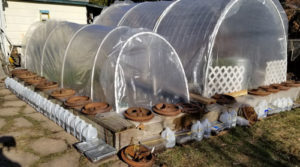Winter Sowing
This is something we have decided to try. We want to THANK the Millwood locations of Rocket Bakery and Starbucks for giving us their empty milk jugs. Under the hoop houses we have green leafy veggies growing. A fresh green salad out of the yard was excellent with our Christmas dinner.
Yet outside of the houses are a line of milk jugs containing seeds that will become starts ready to plant in early spring.
What Should I Plant?
This is the most popular question we are asked by gardeners, and especially by those just starting to grow their own food. And it is a very good question, yet it has a different answer for most people.
Our answer is to plant what you eat. If you are not going to eat it, then it will not be the rewarding experience that it could be. On the agreement form there are a few plants listed that do not work out well at the PPCG.
Second answer to the question is what part of the growing season is it when you want to plant. Different parts of the season work better than others for different plants: some like it cool and some like it hot type of thing.
The Old Farmer’s Almanac Planting Dates is a resource to help you decide when to plant each type of plant.
Hardening off plant starts is a document which gives details on how to get those purchased veggie starts safely into your garden.
What does well at the PPCG
Plants that normally work out well at the PPCG include: Peas, Lettuce, Spinach, Kale, Oniions, Leeks, Summer Squashes, Winter Squashes, Beans, Tomatoes, Peppers, Eggplant, Basil, Radishes, Carrots, Tomatilas, Garlic
What does not do as well at the PPCG
We have had limited success with melons in the garden and Corn requires a very large patch in order to have them pollinate the ears properly.(and if they are not fenced off the deer love to eat the silk on the ears, making the plant unable to produce any kernels). The biggest problem we have with some crops is the local wild life. We have regular visitors of deer and occasionally a moose. We had one rabbit last year so I imagine that we will see more if the Coyotes did not get them. We have devised a system of hoops from plastic ENT(electrical nonmetallic tubing) and rebar covered with chicken wire or netting that does a wonderful job at deterring critter damage.
How should you start or obtain your plants?
There are three categories into which most vegetables fit. Sensitive. Semi-Hardy, and Hardy.
Sensitive plants are damaged by even a light frost. These include the following: Basil, Beans, Cucumbers, Eggplants, Okra, Peppers, Summer Squash, , Pumpkins, Tomatillos, Tomatoes, Peppers, Melons and Winter squash
Semi-Hardy plants are tolerant of light frost. They consist of the following: Arugula, Beets, Carrots, Cauliflower, Celery, Lettuce, Peas, Swiss Chard and Mustards
Hardy vegetables may tolerate hard frost, especially once the plant has a bit of growth behind it. Many of these are great to plant in August or September so they will last into the cold months of winter. These plants consist of: Broccoli, Brussels sprouts, Cabbage, Collards, Kale, Kohlrabi, Onions, Parsley Radishes, Rutabaga, Spinach, Turnips, and Leeks .
You can purchase already started plants from several of local partners and some of the seed companies will also ship started plants. Find these sources on our Community Page. Desert Jewels is right around the corner on Upriver Drive, Holly’ Garden is on Valley Way near Spraguge, North 40 is in Millwood, and, and NWSP is on spraguge towards downtown.
Your can start your own plants at home. We normally have the grow lights on by early February.
And you can plant seeds in the ground at the garden once the time and temperature is correct for that plant type. Semi-hardy and Hardy plants are among the earliest seeds able to go into the soil in Spring.
